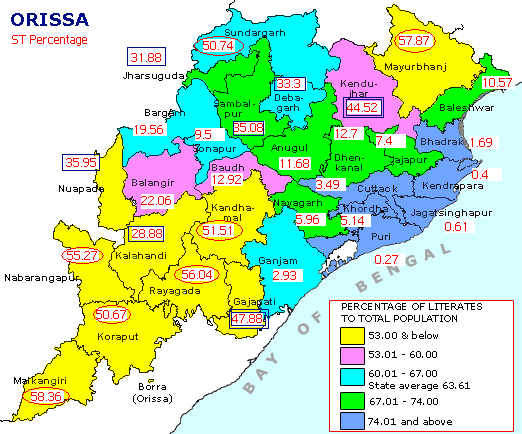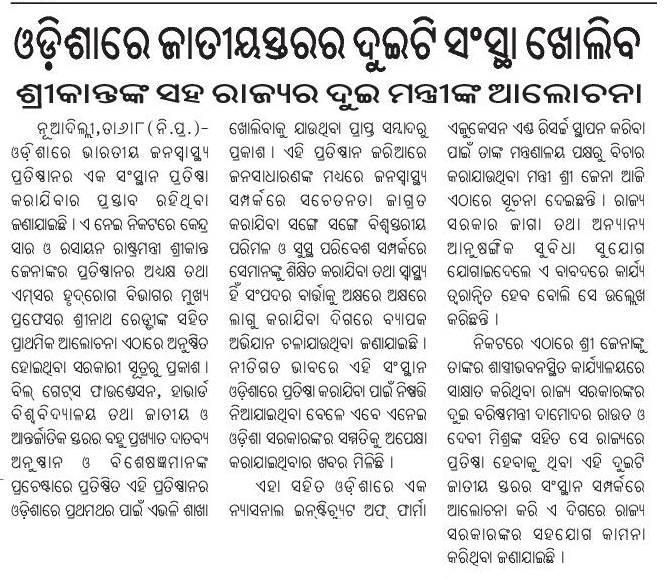The advertisement http://www.cipet.gov.in/pdfs/advt.2010.pdf mentions that CIPET is upgrading its centers to High Learning Centers to impart B.Tech, M.Tech and Ph.D programs with exclusive R & D hubs ARSTPS & LARPM. (Note: I think LARPM was the first R & D hub to be created by CIPET and was mentioned in a Jan 2009 PIB report. But both were also mentioned in a May 2008 Economic Times article.)
As per http://www.cipet.gov.in/research.html:
Technology innovation through dedicated research work by a Core team has been the philosophy of CIPET, which led to the establishment of 02 R&D centres – Laboratory for Advance Research in polymeric Materials (LARPM) & Advance Research School for Technology & Product simulation (ARSTPS) at CIPET Bhubaneswar & Chennai respectively. …
The vision for these R&D Centres have been conceived with objectives of transforming CIPET as a Global research Centre on Polymeric Materials as well as a Resource centre for newer concept development & conversion of concept into reality by Product development on commercial scales. Technology transfer, creation of Intellectual Property (IP), knowledge base with validated documentation would be the key aspects of functioning of R&D entities.
The significance of LARPM & ARSTPS is evident from the fact that they will be chaired by Director General and functioning independently under the Technology & Business development department of Corporate Office. The targets for both R&D centres have been set to pursue the objectives in mission mode. The experienced & competent faculties have been drawn from the existing pool of CIPET along with newly inducted researchers.
Operating model of LARPM & ARSTPS would be influenced with 03 “Rs”- Relevance to industry needs, Result-oriented output, Resourceful base to operate as ‘Centre of excellence”. It is worth mentioning that LARPM has already been sanctioned 03 sponsored projects from Funding agencies of Govt. of India. Similarly, ARSTPS has already initiated industry sponsored projects for Automotive, Medical & Aerospace Industries.
The identified focus areas of LARPM & ARSTPS are as follows:
| |
|
| |
|
|
| |
|
|
| |
|
|
| |
| Biopolymers |
|
Innovative Product Design for Medical, Automobile, Aerospace and Packaging Industries |
|
|
| |
|
|
| |
| Polymer Composites & Nanocomposites |
|
Product and Tool Design Conceptualization (modeling, analysis, process optimization & simulation approach ) |
|
|
| |
|
|
| |
| Functional Plastics, Carbon nanotubes |
|
E- Manufacturing of Prototypes.
|
|
|
| |
|
|
| |
|
Polymer Membranes, Conducting polymers
|
|
Reverse Engineering for metal and conventional
material substitution.
|
|
|
| |
|
|
| |
Development & Characterization of Engg.
Polymers, Blends/Alloys |
|
– |
|
|
| |
|
|
| |
|
The home page of LARPM is http://cipet.gov.in/cipetr&d/. As per http://cipet.gov.in/pdfs/research.pdf there are already 5 students pursuing Ph.D at LARPM. Following are concept drawings of their upcoming building.
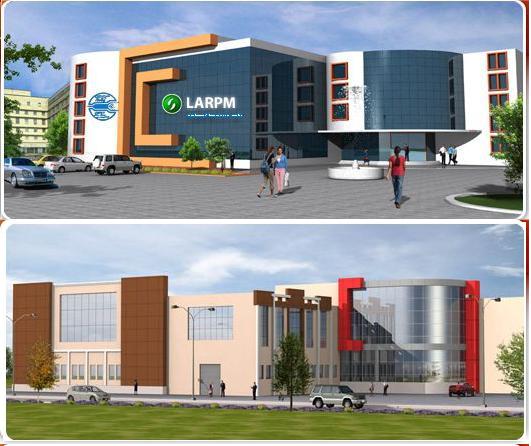
The 2010-2011 admission ad shows the B.tech and M.tech programs that will be offered in 2010-2011. The program that will be offered at CIPET Bhubaneswar are:
- B.Tech in Plastics Engineering/Technology (Bhubaneswar, Ahmedabad, Chennai , Lucknow, Haldia – proposed)
- B.Tech in Manufacturing Engineering & Technology – proposed (Bhubaneswar, Ahmedabad, Chennai, Lucknow)
- M.Tech in Plastics Engineering/Technology (Bhubaneswar, Chennai , Lucknow, Hajipur)
- M.Tech in Polymer Nano Technology (LARPM – Bhubaneswar)
- M.Sc M.Tech in Material Science & Engineering (Bhubaneswar, Chennai, Lucknow).
The only program not listed to be offered at Bhubaneswar, but offered elsewhere, is
- M.Engg in CAD CAM (ARSTPS – Chennai)
Besides the above; all the 15 CIPET centers offer the following diplomas and PG Diplomas:
- Diploma in Plastic mould technology (3 yrs)
- Diploma in Plastics technology (3 yrs)
- PG Diploma in plastic mould design (1 yrs)
- PG Diploma in plastic processing & testing (1.5 yrs)
Finally, the Mancheswar branch of CIPET offers the following programs:
- ITI-Fitter, ITI-Electrician, ITI-IT&ESM and ITI-Welder
- and various short term courses and CAD/CAM courses.
From the above it looks like CIPET Chennai and Bhubaneswar are among the leaders. However neither Odisha nor Tamil Nadu have a NIPER. (The original NIPER is near Mohali and Chandigarh. As part of the 11th plan, new NIPERs were made in Hyderabad, Kolkata, Hajipur, Ahmedabad, Guwahati and Rae Bareli.) I hope Odisha pursues and gets one during the next five year plan.
February 20th, 2010
Following is a letter that Dr. Karmee has sent to many people. This is an excellent work. It is well researched and based on something unique to the location, the Gandhamardan Hills of Baragarh and Balangir. (Considering that many in Orissa may not be aware of Gandhamardan Hills being in Orissa and/or its medicinal values, I have a companion piece on it at https://www.orissalinks.com/orissagrowth/archives/2776.)
I hope others will also focus on unique aspects and attributes of other parts of orissa and write to the higher education task force (HETF) about it.
Respected Mr. Patnaik, CM of Odisha and Members of the Higher Education Task force,
I appreciate the formation of higher education task force by the state government. Also, I am hopeful that such innovative steps will definitely sharpen the higher education of Odisha.
Sirs,
I would like to request the higher education task force to recommend the establishment of a “National Institute of Ayurveda” in Gandhamardan area in western Odisha. I am sure many of us are aware of the potential of Gandhamardan mountain and medicinal plants in it.
In this document, I am presenting the details about the “Gamdhamardan mountain as a reservoir of medicinal plants” with scientific references; thereby, making a case for the establishment of a National Institute of Ayurveda.
I am sure our respected CM, who is the author of the “Garden of Life: An introduction to the Healing Plants of India” will take this matter seriously. Also, I am hopeful that the higher education task force will take the necessary steps; so that, “the medicinal plants in Gamdhamardan mountain” will not get lost with time.
Please have a look on the following write-up for further details.
Thanking you with best regards,
Sanjib
1. “National Institute of Ayurveda” is a must in Gandhamardan area: Introduction and Analysis:
Gandhamardan mountain range is known world wide as a reservoir for medicinal plants. It is located in the western Odisha. More specifically, it is located in between Balangir and Bargarh district (Figure 1).
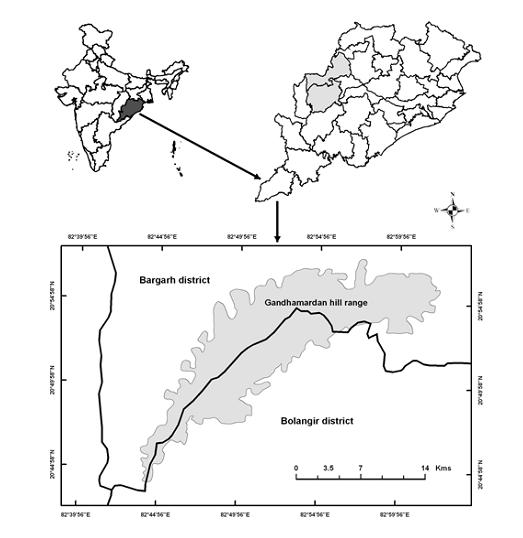
Figure 1 Map showing location of Gandgmardan mountain in between Balangir and Bargarh district
Many eminent scholars of life sciences have done a lot of research on the medicinal plants available in this mountain range. In fact, this hill range is legendary. It has found a place in folklore and mythology -of how Hanuman plucked Bisalyakarani, a medicinal plant, from this hill to save the life of Laxman in the battle of Lanka in “The Ramayana”. In addition, it is known to the whole world how this hill range was at the centre of one of the most prominent ecological movements, that is, the battle between environmentalists keen on protecting aryurvedic plants and the then state-owned Bharat Aluminium Corporation.
Apart from this, there are many scientific journals and books that are mentioning about the potential of medicinal plants available in Gandhamardan mountain (see the reference list)1-5. The state/central govt must establish a “National Institute of Ayurveda” in this place. Right now, both Balangir and Bargarh (Paikmal) each have one Ayurvedic College. Establishing a national level institute on Ayurvedic Medicine will help to a great extent to these colleges by carrying out research in emerging areas. Recently, research on ayurvedic medicine is attracting considerable attention in India and abroad.
It is important to note that, significant developments have boosted systematic research on different aspects of ayurveda and traditional medicine in India. They include the Golden Triangle project jointly managed by CSIR, ICMR and AYUSH; the New Millennium Indian Technology Leadership Initiative (NMITLI) of CSIR and various schemes of DST and DBT.
Additionally, ayurveda is also entering to the mainstream “Drug Discovery”. Following graph show the growing demand of research on Ayurvedic medicine.
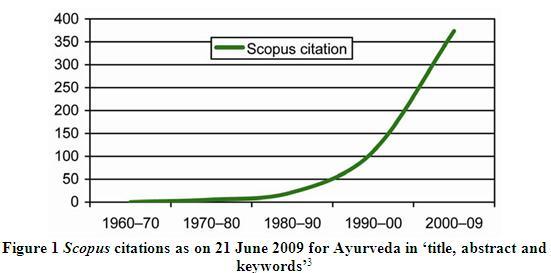
In addition to this, a paper by “Reddy and Pattnaik” from the Forestry and Ecology Division, National Remote Sensing Centre, Hyderabad 500 037, Andhra Pradesh, India points out many interesting facts about “Gandhamardan hill” 4.
It states that, after analyzing and studying the plant resources of Gandhamardan hill range a total of 912 vascular species belonging to 556 genera under 142 families were found. Herbs dominate the flora followed by trees, climbers and shrubs.
Therefore, proper conservation and management plans are needed to save the natural resources, especially medicinal plants, of this sacred hill range. Many botanists fear that this reserve of medicinal plants could be lost in the next few years if proper care is not taken and the indiscriminate collection and smuggling of herbs by local villagers is not stopped. The state forest department which is supposed to guard this botanical wealth is not able to do enough to stop all these developments because they lack of the knowledge and expertise about these plants. In fact, they have no clue which are useful medicinal plants and which are not.
In addition, in these places there is no organized way of farming of the medicinal plants. They just grow in the wild. Therefore, it is very difficult to guard these species. Taking the advantage of this situation any villages or smugglers can walk into the forest and collect the herbs. It is very important that the government should takes steps to grow these plants, harvest these properly, and finally do the marketing of these medicinal plants and herbs in a well organized manner. It should take care of the cultivation and preservation of these plants like it is doing for other forest products like sal seeds or kendu leaves etc.
However, intellectually this problem can be solved by establishment of a National Institute of Ayurveda. The above discussion/ description/ scientific observation strongly suggests the establishment of a National Institute of Ayurveda near Gandhamardan mountain.
2. Following are some of my points in support of establishing a National Institute of Ayurveda in Gandhamardan area:
* West is very much keen on establishing institute on ayurveda. One such successful institution is the National Institute of Ayurvedic Medicine established by Dr. Scott Gerson, USA, (http://niam.com/corp-web/index.htm). This is an example of an institute that has carried out research into Ayurvedic practices to a great extent. In this context, we must use our native expertise. In addition, the National Institute of Ayurvedic Medicine, USA can be a collaborative partner for establishing an institute Gandhamardan area.
* This mountain is very important to all of us and to the world. We should use our natural medicinal resources very judiciously. It is also very surprising that no steps have been taken for the preservation of these high-valued plants. It is the right time to establish a National Institute of Ayurveda in this area.
* As we know this mountain range is a reserve for medicinal plants. Therefore, it will provide adequate environment for cutting edge research/studies in different areas of ayurvedic medicine per international standard.
* Establishment of a National Institute of Ayurveda will help for organized way of farming the medicinal plants; which just grow in the wild. This will also help in preserving different rare species of plants.
* This Institute will provide a boost to the ongoing research/academic activities by Ayurvedic College Balangir and Shri Nrusinghanath Ayurved College Paikmal, Bargarh on this area. Along this line, establishing a National Institute of Ayurveda will make this place a leader in this area of science in national/international level.
* This step will attract companies like Dabur, Ayur, and others to set-up labs/companies in this area.
* From the above discussion it is very clear that research fundings are already available from the leading agencies of India like CSIR (Council for Scientific and Industrial Research), DST (Department of Science & Technology), and DBT (Department of Biotechnology). So, there will be no problem in setting up labs and developing infrastructure.
* There is a lot of synergistic research going on between Ayurvedic, Homeopathic and Allopathic branches of medicine. This is very clear from our day-to-day life as Allopathic doctors often prescribe medicines of Dabur, Neem, etc. Therefore, establishment of such an institute will further enhance the research between this National Institute of Ayurveda with other institutes viz. VSS Medical College, SCB Medical College etc. of the state.
3. The following steps need to be taken to establish a National Institute of Ayurveda in Gandhamardan
* It is important to look in to the web-site of these model Institutes viz. National Institute of Ayurvedic Medicine, USA (http://niam.com/corp-web/index.htm); Gujarat Ayurved University Jamnagar, Gujrat, India (www.ayurveduniversity.com); Rajasthan Ayurved University, Jodhpur Rajasthan (http://www.raujodhpur.org/aboutus.html); National Institute of Ayurved, Jaipur, Rajasthan (http://nia.nic.in/); Ayurvedic university, Hoshiarpur, Punjab; (http://www.financialexpress.com/news/punjab-clears-first-ayurvedic-university-in-hoshiarpur/517911/; This seems to be a new Institute).
* Immediately, the state govt. should present a proposal to the HRD Ministry for establishing National Institute of Ayurveda in Gandhmardan area.
* Along the line of the above institutes, the state govt. in collaboration with govt. of India must establish a National Institute of Ayurveda in Gandhamardan area.
References:
1. Netra Bhanu Pradhan, Gandhamardan – A treasure House of Medical Plants, Navaratna Journal, Jan-Feb, 2008, 41-44.
2. Ayurveda: scientific research and publications, Current Science, 2009, 97( 8), 1117-1122
3. C. Sudhakar Reddy and Chiranjibi Pattanaik, An Assessment of Floristic Diversity of Gandhamardan Hill range, Orissa, India. Bangladesh J. Plant Taxon. 16(1): 29-36, 2009
4. Following are some of the research papers taken from the reference list of the paper 3 (Papers only with the name Gandhamardan are taken)
Brahmam, M. and Saxena, H.O. 1990. Ethnobotany of Gandhamardan hills – Some noteworthy folk medicinal uses. Ethnobotany 2: 71-79.
Brahmam, M. and Saxena, H.O.1990. Phyto-chemical screening of the plants of Gandhamardan hills of Orissa (India) for tannins, saponins, flavonoids and alkaloids. Asian J. Plant Sci. 1: 71-79.
Misra, R.C. 2004. Therapeutic uses of some seeds among the tribals of Gandhamardan hill range, Orissa.Indian J. Traditional Knowledge 3: 105-115.
Misra, R.C. and Behera, G. 1998. Ecological status of Gandhamardan forests using remote sensing techniques. In: Biodiversity Conservation: Problems and Prospects. Proc. National Seminar on Biodiversity Conservation, Bhubaneswar, India, pp. 75-80.
Misra, R.C. and Das, P. 1998. Vegetation status of Nrusinghanath – Harishankar complex, Orissa. J. Econ.Taxon. Bot. 22: 547-554.
Mishra, R.C. and Das, P. 2003. Wild poisonous seeds: Some notable species from Gandhamardan Hill ranges of Orissa. J. Econ. Bot. 27: 513-518.
Misra, R.C. and Das, P. 2004. Vegetation stratification of Gandhamardan hill range, Orissa using remote sensing techniques. J. Econ. Taxon. Bot. 28: 429-438.
Mishra, R.C., Panda, P.C. and Das, P. 1994. Lesser known medicinal uses of plants among the tribals of Gandhamardan hill ranges, Orissa. In: Gupta, B.K. (ed.), Higher Plants of Indian Subcontinent, Vol. III, Bishen Singh Mahendra Pal Singh Publications, Dehra Dun, India, pp. 135-142.
Mishra, R.C., Panda, P.C. and Das, P. 2001. A taxonomic study of the ferns and fern allies of Gandhamardan hills, Orissa. J. Econ. Taxon. Bot. 25: 577-590.
Panigrahi, G. 1963. Gandhamardan Parbat, Orissa – A potential source of important indigenous drugs. Bull. Reg. Res. Lab. 1: 111-116.
Pattanaik, C. and Reddy, C.S. 2007. Medicinal plant resources of Gandhamardan hill range, Orissa: An urgent need for conservation. Natl. Acad. Sci. Lett. 30: 35-38.
Raju, D.C.S. 1960. Vegetation pattern of Gandhamardan hills. Bull. Int. Soc. Trop. Ecol. 1: 21-22.
Saxena, H.O. and Brahmam, M. 1995. Vascular flora of Gandhamardan hills. J. Econ. Taxon. Bot. 19: 113-132.
5. NOTE: This is not the complete list of references. Because of time limitation I have collected as much as I can.
November 4th, 2009
Recently there was some news reports regarding 7 new IIMs. This resulted in reactions from various circles in Orissa, including the CM. The CM shot off a letter to the PM. As per a report in Times of India:
In a letter to Prime Minister Manmohan Singh, Naveen protested the Union government’s decision to ignore Orissa’s "repeated demands" for an IIM.
The Biju Youth Janata Dal has threatened a stir. As per a report in ExpressIndia.com:
The Biju Yuva Janata Dal (BYJD) has threatened to launch a State-wide agitation if the Centre does not consider the State Government’s demand for the establishment of an Indian Institute of Management (IIM) in Orissa.
Even the Oriass Pradesh Congress Committee has chimed in. As per another report in Expressindia.com:
However, the Orissa Pradesh Congress Committee (OPCC) has demanded establishment of an Indian Institute of Management (IIM) in the State.A memorandum was submitted to Sibal by the OPCC at the Congress Bhavan here today.
The memorandum maintained that as Orissa is witnessing rapid industrialisation, the necessity for setting up an IIM is increasingly felt.Stating that such an institute will accelerate the economic development and consolidate the quality of human resources development in Orissa, OPCC requested the Minister to announce an additional IIM for the State along with the seven announced by the Centre.
Besides, OPCC demanded establishment of one national tribal university on the lines of Indira Gandhi Tribal University at Amarkantak in Madhya Pradesh in view of the heavy concentration of tribal population and their economic backwardness.
In a sense this is a good development as this shows that the politicians in Orissa are now aware of the importance of Orissa getting its share of centrally funded institutions. However, their knowledge is half-baked. The news they are reacting to is not a new announcement. On March 28, 2008 when an IIT and 2 central universities for Orissa was announced, there were announcements of new IIMs. At that time it was made clear that the new IITs and IIMs were announced in different states. So based on that, Orissa has nothing to complain about. It got an IIT instead of an IIM. An IIT costs 4 times than that of an IIM and can have its own management school.
It would be good to have an IIM in Orissa. But now the central govt. is stretched to implement the new IITs, IIMs and central universities it has announced for the 11th plan. So it is very unlikely that they will make any commitments for a new IIM. (The IIM in Rajasthan was a recent addition to the list announced on March 28, 2008. It was because of a typo in the speech of Finance Minister Pranab Mukherjee; but the govt. decided to honor his speech.)
What Orissa can do is follow the path of Andhra Pradesh which made a deal with IIM Ahmedabad for a campus in Hyderabad. Orissa can approach one of the other IIMs and make a similar deal for an IIM in Orissa. Because of the proximity, IIM Calcutta would be a good candidate. For now that is the best path. In addition, it should be ready to push hard for an IIM when the 12th plan documents are made.
Finally, what Orissa should be really doing is to focus on the 11th plan documents and budgets and make sure it gets its fair share. For example, the 11th plan document mentions that 5 of the new central universities will have a medical and engineering college during the 11th plan. Orissa should push Central University of Orissa, Koraput to be one of those 5 universities.
August 31st, 2009



